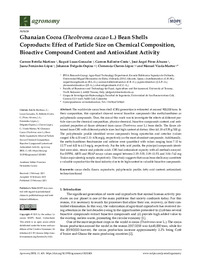Please use this identifier to cite or link to this item:
https://hdl.handle.net/11000/30599Full metadata record
| DC Field | Value | Language |
|---|---|---|
| dc.contributor.author | Botella-Martinez, Carmen | - |
| dc.contributor.author | Lucas González, Raquel | - |
| dc.contributor.author | Ballester-Costa, Carmen | - |
| dc.contributor.author | Pérez-Alvarez, José Angel | - |
| dc.contributor.author | Fernandez-Lopez, Juana | - |
| dc.contributor.author | Delgado Ospina, Johannes | - |
| dc.contributor.author | Chaves Lopez, Clemencia | - |
| dc.contributor.author | Viuda-Martos, Manuel | - |
| dc.contributor.other | Departamentos de la UMH::Tecnología Agroalimentaria | es_ES |
| dc.date.accessioned | 2024-01-24T09:18:55Z | - |
| dc.date.available | 2024-01-24T09:18:55Z | - |
| dc.date.created | 2021-02 | - |
| dc.identifier.citation | Agronomy Volume 11 Issue 2 (2021) | es_ES |
| dc.identifier.issn | 2073-4395 | - |
| dc.identifier.uri | https://hdl.handle.net/11000/30599 | - |
| dc.description.abstract | The worldwide cocoa bean shell (CBS) generation is estimated at around 900,000 tons. In their composition, this coproduct showed several bioactive compounds like methylxanthines or polyphenolic compounds. Thus, the aim of this work was to investigate the effects of different particle sizes on the chemical composition, physico‐chemical, bioactive compounds content, and antioxidant properties of flours obtained from cocoa (Theobroma cacao L.) bean shells. The flours obtained from CBS with different particle sizes had high content of dietary fiber (61.18–65.58 g/100 g). The polyphenolic profile identified seven compounds being epicatechin and catechin (values ranged 4.56–6.33 and 2.11–4.56 mg/g, respectively) as the most abundant compounds. Additionally, the methylxanthines theobromine and caffeine were quantified with values ranging from 7.12 to 12.77 and 4.02 to 6.13 mg/g, respectively. For the fatty acid profile, the principal compounds identified were oleic, stearic and palmitic acids. CBS had antioxidant capacity with all methods assayed. For DPPH, ABTS and FRAP assays values ranged between 2.35–5.53, 3.39–11.55, and 3.84–7.62 mg Trolox equivalents/g sample, respectively. This study suggests that cocoa bean shells may constitute a valuable coproduct for the food industry due to its high content in valuable bioactive compounds | es_ES |
| dc.format | application/pdf | es_ES |
| dc.format.extent | 15 | es_ES |
| dc.language.iso | eng | es_ES |
| dc.publisher | MDPI | es_ES |
| dc.rights | info:eu-repo/semantics/openAccess | es_ES |
| dc.rights.uri | http://creativecommons.org/licenses/by-nc-nd/4.0/ | * |
| dc.subject | cocoa shells | es_ES |
| dc.subject | flours | es_ES |
| dc.subject | coproducts | es_ES |
| dc.subject | polyphenolic profile | es_ES |
| dc.subject | fatty acid content | es_ES |
| dc.subject | antioxidant | es_ES |
| dc.subject | techno‐functional | es_ES |
| dc.subject.other | CDU::6 - Ciencias aplicadas::62 - Ingeniería. Tecnología | es_ES |
| dc.title | Ghanaian Cocoa (Theobroma cacao L.) Bean Shells Coproducts: Effect of Particle Size on Chemical Composition, Bioactive Compound Content and Antioxidant Activity | es_ES |
| dc.type | info:eu-repo/semantics/article | es_ES |
| dc.relation.publisherversion | https://doi.org/10.3390/agronomy11020401 | es_ES |

View/Open:
Ghanaian cocoa bean shells (1).pdf
716,63 kB
Adobe PDF
Share:
.png)
